Clearly , I've been missing out.
Navigation
Install the app
How to install the app on iOS
Follow along with the video below to see how to install our site as a web app on your home screen.
Note: This feature may not be available in some browsers.
More options
You are using an out of date browser. It may not display this or other websites correctly.
You should upgrade or use an alternative browser.
You should upgrade or use an alternative browser.
Kessil LED vs Halide T5
- Thread starter BoomCorals
- Start date
- Tagged users None
- Joined
- Sep 18, 2017
- Messages
- 5,597
- Reaction score
- 3,447
The lack "a quantity" of lower than 450nm light in the LEd's is why the frag didn't respond like it did w/ the T5's...
I said there are no magic photons but there are different photons..
you know it's kind of silly arguing a "one off" frag response.. but finding out if there is an easy to understand reason benefits all..
Say someone gets "that frag" but runs all coral plus tubes and it turns brown..
somewhere "out there" there is a set of pie charts that break down many LEd spectral components in percent output. Can't find it currently and I also know its a bit outdated..
I said there are no magic photons but there are different photons..
you know it's kind of silly arguing a "one off" frag response.. but finding out if there is an easy to understand reason benefits all..
Say someone gets "that frag" but runs all coral plus tubes and it turns brown..
somewhere "out there" there is a set of pie charts that break down many LEd spectral components in percent output. Can't find it currently and I also know its a bit outdated..
Last edited:
- Joined
- Jan 8, 2014
- Messages
- 15,906
- Reaction score
- 50,359
So are you saying that the coral was brown because the leds are missing "true actinic" or are you implying the frag was brown because it was kept under a spectrum equal to all coral plus bulbs or are just trying to cause drama? It's very unclear with your posts.The lack "a quantity" of lower than 450nm light in the LEd's is why the frag didn't respond like it did w/ the T5's...
I said there are no magic photons but there are different photons..
you know it's kind of silly arguing a "one of" frag response.. but finding out if there is an easy to understand reason benefits all..
Say someone gets "that frag" but runs all coral plus tubes and it turns brown..
somewhere "out there" there is a set of pie charts that break down many LEd spectral components in percent output. Can't find it currently and I also know its a bit outdated..
The lack "a quantity" of lower than 450nm light in the LEd's is why the frag didn't respond like it did w/ the T5's...
I said there are no magic photons but there are different photons..
you know it's kind of silly arguing a "one of" frag response.. but finding out if there is an easy to understand reason benefits all..
Say someone gets "that frag" but runs all coral plus tubes and it turns brown..
somewhere "out there" there is a set of pie charts that break down many LEd spectral components in percent output. Can't find it currently and I also know its a bit outdated..
All three of the light sources I posted have 420nm and well below and in higher concentration than every other part of the spectrum with the exception of 450-460nm. Again, what you're posting makes no sense when the vast majority of the lights spectrum is right in the range you're addressing. What that has to do with your original question regarding 6500k has me even more lost; higher "K" ratings imply more blue content.
- Joined
- Sep 18, 2017
- Messages
- 5,597
- Reaction score
- 3,447
Yes. Old habit.. one off sounds dumb..Are you trying to say "one off"
Prefer numbers. Or at least like this:All three of the light sources I posted have 420nm and well below and in higher concentration than every other part of the spectrum with the exception of 450-460nm. Again, what you're posting makes no sense when the vast majority of the lights spectrum is right in the range you're addressing. What that has to do with your original question regarding 6500k has me even more lost; higher "K" ratings imply more blue content.
http://www.advancedaquarist.com/2013/12/lighting
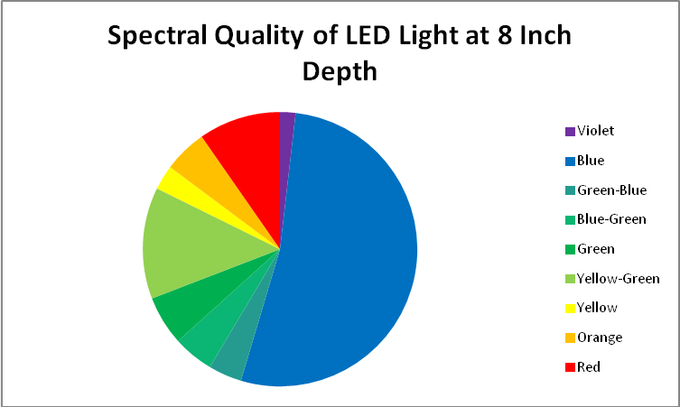
- Joined
- Sep 18, 2017
- Messages
- 5,597
- Reaction score
- 3,447
All three of the light sources I posted have 420nm and well below and in higher concentration than every other part of the spectrum with the exception of 450-460nm. Again, what you're posting makes no sense when the vast majority of the lights spectrum is right in the range you're addressing. What that has to do with your original question regarding 6500k has me even more lost; higher "K" ratings imply more blue content.
Skip the 6500k part.. not important..
Charts don't exactly show the real picture.. and don't want to do the calculus to guess anyways..
besides many are "smoothed" (lets not go there)
until I see proof to the contrary I'm still hypothesizing the large quantity of "actinic" in the t5 is the trick..
If you got numbers or percents for 420 and less I'll gladly accept them..
Again, and to make it clearer.. a "guess" as to why on my part.
So lets reverse this a bit .. Why do you think it stayed brown w/ the LED's then went "colored" w/ the t5?
Last edited:
- Joined
- Nov 5, 2017
- Messages
- 45
- Reaction score
- 17
I think his point was at 414.00 nano meters.I'm totally lost on what the heck your point is.
420nm has certainly been a staple for as long as I can remember; when I started reef keeping (around '94) we had VHOs in actinic, 50/50, and daylight when it came to florescent lighting. I dont think there is any denying its importance.
In the case of BoomCorals coral, I dont believe the coral was in his frag tank with the A360WEs as it's fairly new. Impossible for me to say it would perform any differently than the other configurations he's had if it hasn't been.
Edit: I do believe his T5 combination of lights are peaking around 450-460nm though.
In the case of BoomCorals coral, I dont believe the coral was in his frag tank with the A360WEs as it's fairly new. Impossible for me to say it would perform any differently than the other configurations he's had if it hasn't been.
Edit: I do believe his T5 combination of lights are peaking around 450-460nm though.
- Joined
- Sep 18, 2017
- Messages
- 5,597
- Reaction score
- 3,447
Every ATI tube is (except "actinic") is a variation on this w/ little difference on the blue region.
These also are similar to every decent LEd..w/ the exception of a weaker cyan region..
He ran one tube of the "actinic" w/ 7 tubes of "like" spectrum
Making it 1/8 the power in a band below 425-ish..
Still awaiting numbers on LEd's power spectrum at 425-ish and lower..
not just charts..
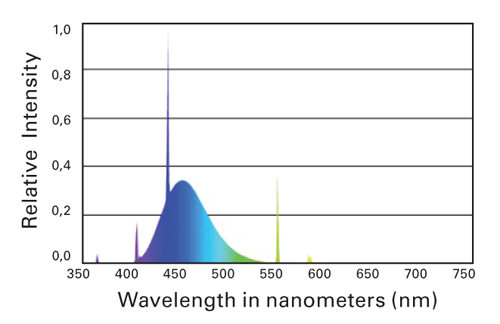
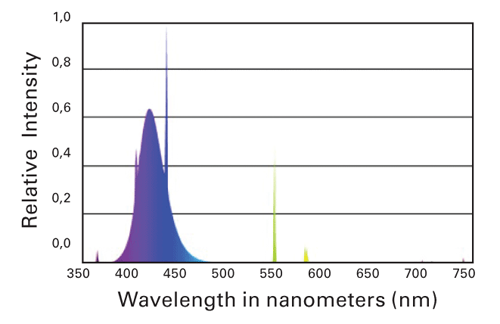
These also are similar to every decent LEd..w/ the exception of a weaker cyan region..
He ran one tube of the "actinic" w/ 7 tubes of "like" spectrum
Making it 1/8 the power in a band below 425-ish..
Still awaiting numbers on LEd's power spectrum at 425-ish and lower..
not just charts..


It isnt 1/8th the "power" because every light in his array has large amounts of light in the 420nm spectrum. All of the "charts" reference a relative intensity like the ones you just posted.
- Joined
- Sep 18, 2017
- Messages
- 5,597
- Reaction score
- 3,447
It isnt 1/8th the "power" because every light in his array has large amounts of light in the 420nm spectrum. All of the "charts" reference a relative intensity like the ones you just posted.
No, no they don't.. though you need real analysis to confirm that.
Now you are correct. it is more than 1/8 probably (or calculated, maybe even less).. still less than the LEd's..
Look this is all a crude estimation but I think the premise holds.. The t5 array has way more <425nm "blue" than any of the tested LEDs..
Radiometric watts:
http://aquanerd.com/2015/07/ati-giesemann-t5-comparison-part-2.html
Generic b/W led:
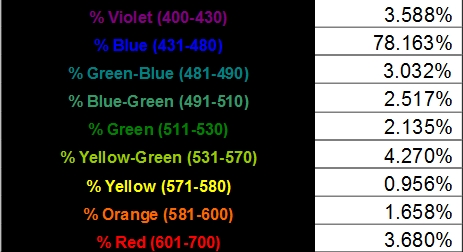
20,000k MH
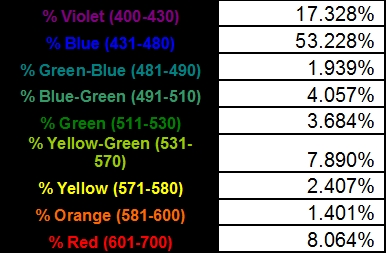
http://www.saltcorner.com/Articles/Showarticle.php?articleID=141
sort of pointless comparison , thought I'd better add that ..
Last edited:
Yep. 300 PAR in all cases.Thank you...
err.. what color does it look like under normal daylight?
Since I have yet to see any proof of "magic photons" almost everything has to to w/ spectrum components and/or intensity..
Though "stroboscopic" effects of multi-colored LED emitters has some possibilities to add another complication..
BTW: did you measure the PAR at the frag spot under each of those lights?
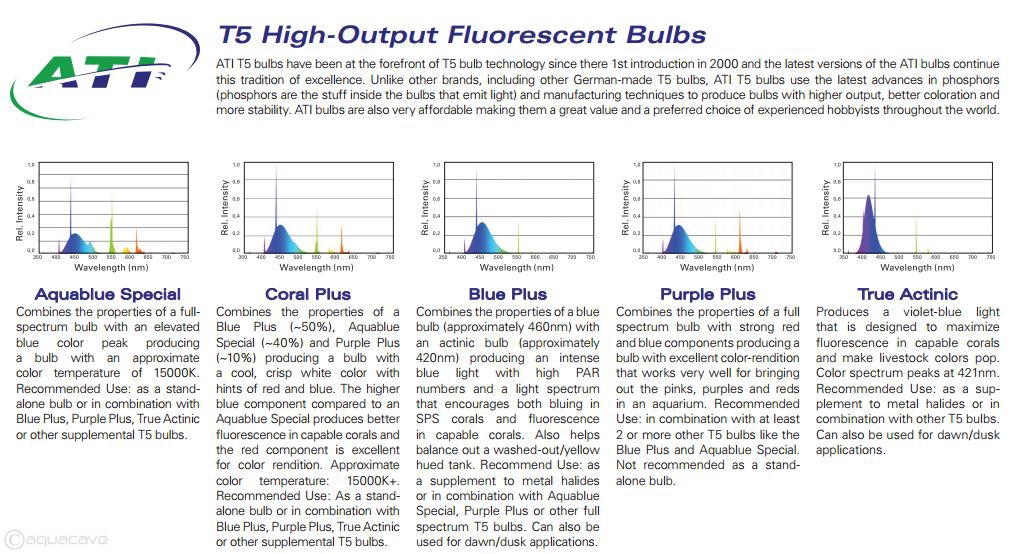
The change was real. It was brown when first put under the T5. Not sure what you’re trying to insinuate...curiosity...how much is real pigment.. how much is "forced"..guess even that is arguable..
my guess for the effect.. The True actinic which is lacking in almost all the mentioned LEds..at least in quantity..
composes 1/8 of the output of the T5's..
Use an Orphek V4.. Run ch 3 and 2 (or 4) heavy...
- Joined
- Sep 18, 2017
- Messages
- 5,597
- Reaction score
- 3,447
Yep. 300 PAR in all cases.
Thanks..
I appreciate the discussion but remember this is a basic experiment I’m doing for whatever it provides. If you want something more scientific, there are other sources, or you could spend thousands of your own $ to do it.  This experiment is about growth and color. All other things in my tank are equal except the lights. I did this mostly for myself, since I grow corals to then frag them for sale, then need those colonies to heal and grow some more, so I can frag them again. But I figured I’d post this one for others to see too for fun.
This experiment is about growth and color. All other things in my tank are equal except the lights. I did this mostly for myself, since I grow corals to then frag them for sale, then need those colonies to heal and grow some more, so I can frag them again. But I figured I’d post this one for others to see too for fun.
So chat away, discussion is encouraged. But be nice!
So chat away, discussion is encouraged. But be nice!
- Joined
- Sep 18, 2017
- Messages
- 5,597
- Reaction score
- 3,447
I'm not insinuating anything.. certainly don't question your observation..The change was real. It was brown when first put under the T5. Not sure what you’re trying to insinuate...
but think of it this way.. Put a blue object under a red light and it looks black..
Put a florescent pigment under a light w/ no stimulating wavelength and it doesn't fluoresce..
If some of the new color was caused by flourecence it will be less in daylight and true pigments will show..most likely..
If I had to guess, it would be less blue but not brown under "daylight" .. but again, not really a main part of what I was trying to get at..
Like I posted earlier. forget it.. I was just curious..
Still recommend trying it under an atlantik w/ heavy boost in the purple/blue range.
It was all brown when it was first under the T5. The T5 in my estimation is what caused the change. If it was the actinic or whatever, so be it. It was something that kessil and radion g4 pros were not providing it seems.I'm not insinuating anything.. certainly don't question your observation..
but think of it this way.. Put a blue object under a red light and it looks black..
Put a florescent pigment under a light w/ no stimulating wavelength and it doesn't fluoresce..
If some of the new color was caused by flourecence it will be less in daylight and true pigments will show..most likely..
If I had to guess, it would be less blue but not brown under "daylight" .. but again, not really a main part of what I was trying to get at..
Like I posted earlier. forget it.. I was just curious..
Still recommend trying it under an atlantik w/ heavy boost in the purple/blue range.
When I put it back under LED today it looked the same as under the T5. The colors as pictured.
- Joined
- Sep 18, 2017
- Messages
- 5,597
- Reaction score
- 3,447
since I grow corals to then frag them for sale, then need those colonies to heal and grow some more, so I can frag them again. But I figured I’d post this one for others to see too for fun.
You should then more than appreciate telling your customers "this coral requires a lot of violet light for good color and growth" vs .."go buy some t5's"...
sorry bit of levity...
- Joined
- Sep 18, 2017
- Messages
- 5,597
- Reaction score
- 3,447
It was all brown when it was first under the T5. The T5 in my estimation is what caused the change. If it was the actinic or whatever, so be it. It was something that kessil and radion g4 pros were not providing it seems.
When I put it back under LED today it looked the same as under the T5. The colors as pictured.
Now will it "stick".. any bets?
I'm actually betting against it but it's possible..but that has ZERO to do w/ one light source topology vs another..
See I'd never say "it's the T5's" but its something in the spectrum of the t5..and the likely area is the "actinic" band..
I know it's sort of splitting hairs but the only way I can, personally, look at it..
a photon is a photon regardless of source..
Last edited:
Similar threads
-
- Question
- Replies
- 9
- Views
- 155
- Replies
- 3
- Views
- 399



















